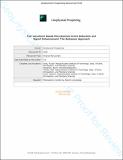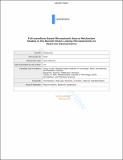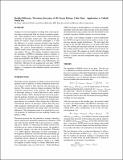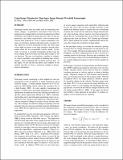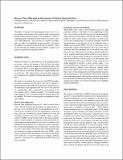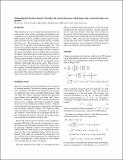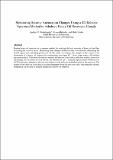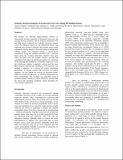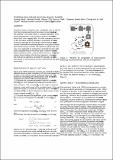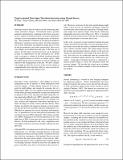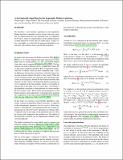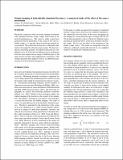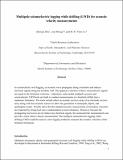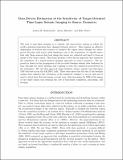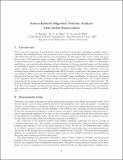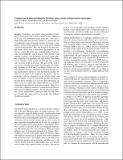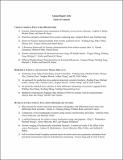Browsing ERL Industry Consortia Technical Reports by Issue Date
Now showing items 21-40 of 456
-
Full-waveform Based Microseismic Event Detection and Signal Enhancement: The Subspace Approach
(Massachusetts Institute of Technology. Earth Resources Laboratory, 2013)Microseismic monitoring has proven to be an invaluable tool for optimizing hydraulic fracturing stimulations and monitoring reservoir changes. The signal to noise ratio (SNR) of the recorded microseismic data varies ... -
Full-waveform Based Microseismic Source Mechanism Studies in the Barnett Shale: Linking Microseismicity to Reservoir Geomechanics
(Massachusetts Institute of Technology. Earth Resources Laboratory, 2013)Microseismic moment tensor (MT) contains important information on the reservoir and fracturing mechanisms. Difficulties arise when attempting to retrieve complete MT with conventional amplitude inversion methods if only ... -
Double-Difference Waveform Inversion of 4D Ocean Bottom Cable Data: Application to Valhall, North Sea
(Massachusetts Institute of Technology. Earth Resources Laboratory, 2013)Changes in reservoir properties resulting from extracting hydrocarbons and injecting fluid are critical to optimize production. These properties can be characterized using waveform inversions of time-lapse seismic data. ... -
Using Image Warping for Time-lapse Image Domain Wavefield Tomography
(Massachusetts Institute of Technology. Earth Resources Laboratory, 2013)Time-lapse seismic data are widely used for monitoring subsurface changes. A quantitative assessment of how reservoir properties have changed allows for better interpretation of fluid substitution and migration during ... -
Reverse Time Migration in the presence of known sharp interfaces
(Massachusetts Institute of Technology. Earth Resources Laboratory, 2013)We propose using the forward propagated source wave to create synthetic receiver data on the surfaces of the computational domain where real receiver data is not available as a means of exploiting known information about ... -
Estimating the fracture density of small-scale vertical fractures when large-scale vertical fractures are present
(Massachusetts Institute of Technology. Earth Resources Laboratory, 2013)When fractures are vertical, aligned and their dimensions are small relative to the seismic wavelength, the medium can be considered to be an equivalent Horizontal Transverse Isotropic (HTI) medium. However, geophysical ... -
Effect of borehole stress concentration on compressional wave velocity measurements
(Massachusetts Institute of Technology. Earth Resources Laboratory, 2013)Formation elastic properties near a borehole may be altered from their original state due to the stress concentration around the borehole. This could lead to a biased estimation of formation elastic properties measured ... -
Efficient Double-Beam Characterization for Fractured Reservoir
(Massachusetts Institute of Technology. Earth Resources Laboratory, 2012-06)We proposed an efficient target-oriented method to characterize seismic properties of fractured reservoirs: the spacing between fractures and the fracture orientation. Based on the diffraction theory, the scattered wave ... -
Monitoring Seismic Attenuation Changes Using a 4D Relative Spectrum Method in Athabsca Heavy Oil Reservoir, Canada
(Massachusetts Institute of Technology. Earth Resources Laboratory, 2012)Heating heavy oil reservoirs is a common method for reducing the high viscosity of heavy oil and thus increasing the recovery factor. Monitoring these changes in the reservoir is essential for delineating the heated region ... -
Seismic characterization of fractured reservoirs using 3D double beams
(Massachusetts Institute of Technology. Earth Resources Laboratory, 2012)We propose an efficient target-oriented method to characterize seismic properties of fractured reservoirs: the spacing between fractures and the fracture orientation. We use both singly scattered and multiply scattered ... -
Predicting stress-induced anisotropy around a borehole
(Massachusetts Institute of Technology. Earth Resources Laboratory, 2012)Formation elastic properties near a borehole may be altered from their original state due to the stress concentration around the borehole. This could result in a biased estimation of formation properties but could provide ... -
Target-oriented Time-lapse Waveform Inversion using Virtual Survey
(Massachusetts Institute of Technology. Earth Resources Laboratory, 2012)Time-lapse seismic data are widely used for monitoring time-variant subsurface changes. Conventional analysis provides qualitative information by comparing results from consecutive surveys, whereas waveform inversion can ... -
A fast butterfly algorithm for the hyperbolic Radon transform
(Massachusetts Institute of Technology. Earth Resources Laboratory, 2012)We introduce a fast butterfly algorithm for the hyperbolic Radon transform commonly used in seismic data processing. For two-dimensional data, the algorithm runs in complexity O(N[superscript 2] logN), where N is representative ... -
A unified framework for relative source localization using correlograms
(Massachusetts Institute of Technology. Earth Resources Laboratory, 2012)We study the problem of determining an unknown event location relative to previously located events using a single monitoring array in a monitoring well. We show that using the available information about the previously ... -
Seismic imaging of hydraullically-stimulated fractures: A numerical study of the effect of the source mechanism
(Massachusetts Institute of Technology. Earth Resources Laboratory, 2012)We present a numerical study of seismic imaging of hydraulically stimulated fractures using a single source from an adjacent fracturing-process. The source is either a point force generated from the perforation of the ... -
Multipole seismoelectric logging while drilling (LWD) for acoustic velocity measurements
(Massachusetts Institute of Technology. Earth Resources Laboratory, 2012)In seismoelectric well logging, an acoustic wave propagates along a borehole and induces electrical signals along the borehole wall. The apparent velocities of these seismoelectric signals are equal to the formation ... -
Data-Driven Estimation of the Sensitivity of Target-Oriented Time-Lapse Seismic Imaging to Source Geometry
(Massachusetts Institute of Technology. Earth Resources Laboratory, 2012)The goal of time-lapse imaging is to identify and characterize regions in which the earth's material properties have changed between surveys. This requires an effective deployment of sources and receivers to monitor the ... -
Source-Indexed Migration Velocity Analysis with Global Passive Data
(Massachusetts Institute of Technology. Earth Resources Laboratory, 2012)The reverse-time migration of global seismic data generated by free-surface multiples is regularly used to constrain the crustal structure, but its accuracy is to a large extent determined by the accuracy of the 3-D ... -
Comparison of microearthquake locations using seismic interferometry principles
(Massachusetts Institute of Technology. Earth Resources Laboratory, 2012)Mapping, localization, and general characterization of problems in reservoir fracture systems is one of the most important in oil, gas, and geothermal energy production. One way to study and monitor these fracture systems ... -
Annual Report 2012 Table of Contents
(Massachusetts Institute of Technology. Earth Resources Laboratory, 2012)

